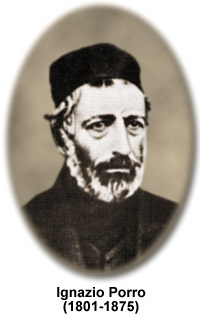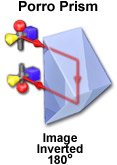Ignazio Porro
(1801-1875)

Ignazio Porro’s primary contribution to optics was an innovative prism image erecting system that is commonly used in binoculars and stereomicroscopes, though he also invented and improved a number of other scientific instruments. Today Porro is often considered to have been ahead of his time in many ways, the Italian engineer receiving little acclaim or monetary compensation for his innovative devices, which only came to be fully appreciated and widely utilized after his death. In fact, when Ernst Abbe attempted to patent binoculars containing his own prism erecting system in 1893, the physicist was very surprised to find that someone else had invented and patented the design decades earlier. Despite his own intense work in the field of optics, Abbe had never heard of the inventor, a telling indication of Porro’s difficulties.
Porro was the son of an Italian engineer-lieutenant and, like his father, joined the military, serving initially as a cadet in the artillery and working his way up to a major in the reserve before he retired from service in 1842. Throughout many of his years in the military, Porro surveyed lands and developed improvements for the geodetic instruments he utilized. His innovations helped make surveying a more expedient and accurate endeavor. Around 1839, Porro began referring to his instruments as tachymeters and coined the term tachymetry. Porro’s interest in scientific devices carried over into his civilian life after he left the military, and he originally opened a workshop in Turin, Italy, but moved to Paris, where he opened the Institut Technomatique, five years later. During his years in Paris, Porro was very productive. In 1847, he developed an improved asymmetrical camera lens that enhanced image quality and a few years later he became the first person to promote the use of tele-lenses to photograph remote edifices. It was also during this time that Porro invented his direct-vision prism image erecting system, which he patented in both France and England in 1854.

A right-angle prism oriented so that light enters and exits through the hypotenuse face is often referred to as a Porro prism. When a single Porro prism is utilized, the incident light beam undergoes two internal reflections after it enters the prism and is deviated by 180 degrees upon exiting, resulting in an image that is inverted top to bottom, but is not reversed right to left.
In order to form erect reversed images with the Porro prism, two of the prisms may be doubled together orthogonally (a design patented by Porro) to first invert and then reverse light beams. The twin prisms fold the light path of an optical system and also displace the image both horizontally and vertically by half the length of the hypotenuse in each direction. Porro prisms are widely utilized in stereomicroscopes to produce upright images.
Porro reportedly built primarily monocular instruments with his pioneering prism system, and even presented two telescopes he designed to Emperor Napoleon III of France in 1855. Yet, despite the novelty of Porro’s prism-based inventions, the scientific community did not receive them with much enthusiasm, and he was never able to produce the designs on a large scale. Though technical issues likely were largely responsible for Porro’s lack of professional success, it has been suggested that his reputation among other men of science was problematic at times, which may also have been a factor in some of his troubles. For example, in the late 1850s, Henri Hureau de Sénarmont, a renowned French mineralogist, issued a report that contained a denunciation of both Porro’s methods and character, information that could have discouraged others from purchasing Porro’s instruments.
In his later years, Porro returned to Italy, where he taught tachymetry in Florence and then surveying theory in Milan. He continued to build instruments during this period and founded multiple workshops, none of which were very successful. When Porro died in 1875, he was experiencing serious financial hardship and could hardly have thought that one day his name would be famous in the world of optics. Nevertheless, Porro prism binoculars, which were first conceived in the mid-1800s, were refined by other scientists and became one of the most popular varieties of binoculars by the dawn of twentieth century. In fact, the instruments, which enjoy simplicity of design as well as greater depth perception and a wider field-of-view than many other binocular designs, continue to be sold around the globe in the early twenty-first century.
